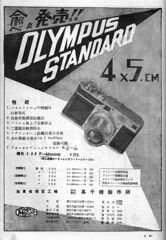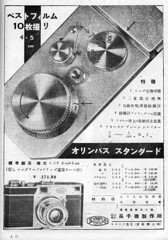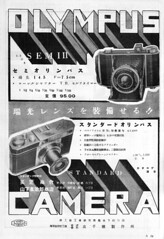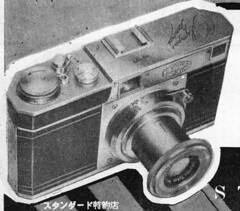Olympus Standard
The Olympus Standard (オリンパス・スタンダード) is a rangefinder camera, made in 1937 by Takachiho (predecessor of Olympus) at prototype level.
Contents
Description
The Olympus Standard takes 4×5cm pictures on 127 film. It has a coupled rangefinder combined with the viewfinder, and a focal plane shutter with T, B, 20–500 speeds. The advance knob is at the right end of the top plate, as seen by the photographer. It simultaneously advances the film and winds the shutter, and its base is surrounded by an exposure counter. There is a red window at the left of the back, protected by a sliding cover and used to set the first exposure. The back is opened by a key under the camera, and is removable together with the bottom plate. There is a plate under the camera at the center, that slides forward to act as a support leg. Inside the back, the camera has a removable pressure plate, said to be made of aluminium.[1]
On the top plate, immediately to the left of the advance knob, there is a hole for a distant release connection. The shutter release itself is just behind, combined with a two-position selector, marked T and I. It is said that this selector is used for film loading, to disconnect the film advance from the shutter operation. When set on the T position, the coupling mechanism is disengaged and the film is freely wound until the number 1 appears in the red window, then the exposure counter is manually reset to zero and the selector is switched to the I position for normal operation.[2] (It is possible that the same selector is also used for T exposures, hence the T and I indications.)[3]

|
| Top plate and controls. From Asahi Camera August 1937. (Image rights) |
To the left of the distant release hole is the shutter speed selector, with the following positions: B, 20, 30, 50, 100, 200, 500. Just to the left there is a step in the top plate, corresponding to the viewfinder window, with a small arrow engraved to indicate the selected shutter speed. The accessory shoe is slightly offset to the left, and the serial number is engraved just in front of it: No 1xx. The left end of the top plate is engraved Olympus Standard in cursive script. The rangefinder window is at the left end of the body. Between the two windows is an OLYMPUS TOKYO logo. The same logo is also embossed in the back leather, on the right.
The Olympus Standard has an interchangeable lens, screwed to the front of the focusing helical.[4] The helical itself is attached to the body and does not come off, the same as on the Contax. It is driven by a tab and has an infinity lock. Quite unusually, the distance scale is fixed and the depth-of-field indications are on the rotating part. No other lens mount is visible, and it is unclear how the tele and wide angle lenses would have been focused or coupled to the rangefinder.
The standard lens is a Zuiko 65mm f/3.5, with an all chrome finish. It is collapsible, with an internal three-lug bayonet to maintain the extended position. The aperture ring is on the front and the aperture scale goes from 3.5 to 22. The lens bezel is black, with the following marking in white: Takatiho Tokyo No.xxxx Zuiko 1:3.5 f=65mm.
History
Origin
The Olympus Standard was the first camera designed by Sakurai Eiichi. It is said that Sakurai was engaged in 1935 because Yamashita Takeshi, founder of the company, wanted to make cameras.[5] However the company had not yet made its first experimental camera lenses at the time, and the first commitment given to Sakurai was a revolving head for a microscope.[6] Yamashita wanted to emulate the Carl Zeiss and Zeiss Ikon companies, and the Olympus Standard and Semi Olympus II (designed by Kitakawa) were positioned as rivals of the Contax and Ikonta.[7]
Announcement and lens range
The Olympus Standard was presented to the public in 1937. It was advertised in Asahi Camera from June to December, and was featured in the new products column of the August issue of the same magazine.[8]

|

|

|
| June 1937 | July 1937 | August 1937 |
| Advertisements for the Olympus Standard in Asahi Camera. (Image rights) | ||
The first advertisements from June to August, reproduced above, quote the price as ¥275 for the camera with Zuiko (written 瑞光) 6.5cm f/3.5 standard lens, including a case, lens hood and cable release.[9] They give a list of interchangeable lenses, summarized below:
- Zuiko 65mm f/3.5: ¥100;
- Zuiko 65mm f/2.7: ¥145;
- Zuiko or Falcon[10] 65mm f/2: ¥225;
- Zuiko 50mm f/4.5: ¥90;
- Zuiko 135mm f/6.3 or f/4.5: ¥130.
Depending on the documents, the f/2 standard lens and 135mm tele lens are generally announced as "planned" (発売予定) or "available soon" (近日発売),[11] certainly indicating that they were at a less advanced stage of development. In the June advertisement, the f/2 lens is called Zuiko instead of Falcon, and the maximal aperture of the tele lens is given as f/6.3 instead of f/4.5. It is not known if these are mistakes or if the planned name and aperture actually changed.[12] (Another minor difference in the documents is that the focal length is given in millimetres in June and July, and in centimetres in August.)
The f/2.7 and f/2 designs were part of a program subsidized by the Japanese government, to develop high-aperture lenses from Japanese optical glass (see Olympus); the f/2.7 has six elements in four groups and the f/2 has six elements in five groups.[13]

|
| Olympus Standard no.101, perhaps with Zuiko f/2.7. From Asahi Camera June 1937. (Image rights) |
The June advertisement shows a picture of body no.101, perhaps the first prototype. The lens is presumably a Zuiko f/2.7: the front element has a larger diameter than the better known 65mm f/3.5, and a "Zuiko" marking is faintly visible on the front bezel. The July and August advertisements show a camera with 65mm f/3.5 lens no.1300.
All the advertisements were placed by the maker Takachiho Seisakusho (distinguished by the Ministry of the Navy), and show the same OLYMPUS TOKYO logo as engraved on the cameras. That dated August mentions two authorized dealers for the Standard: Yamashita Yūjirō Shōten and Misuzu Shōkai.
The announcement in Asahi Camera August 1937, reproduced below, gives a summary of the features. It mentions the release price of ¥275 and the availability of tele, wide-angle and "wide-aperture" lenses.

|
| Announcement in Asahi Camera August 1937. (Image rights) |
Later advertisements

|

|

|
| September 1937 | October 1937 | November and December 1937 |
| Advertisements for the Olympus Standard in Asahi Camera. (Image rights) | ||
The advertisements placed from September to December, reproduced above, give no price and do not mention interchangeable lenses, other than the 65mm f/3.5. This might indicate that the company had already abandoned the idea of selling the camera. The two authorized dealers are nonetheless mentioned till the end.
From October, half of the advertisement is devoted to the Semi Olympus II. The picture displayed in November and December shows body no.107.

|
| Olympus Standard no.107, Zuiko 65mm f/3.5. From Asahi Camera November 1937. (Image rights) |
The end
The development of the Standard was stopped after only ten prototypes were made,[14] from no.101 to 110.
It is sometimes said that the Standard was abandoned because the military required the company to concentrate on other projects,[15] an explanation which is perhaps oversimplified. The military demands surely contributed to the abandon of the project: military orders became more numerous after the outbreak of war with China in 1937, and these high-priority tasks certainly drove the attention of the most qualified engineers and technicians, making them unavailable for other tasks.
Sakurai Eiichi once said that the company did not have enough resource to reach serial production of such a complex model: "Even if we could design and make the first prototypes of the Olympus Standard, if the camera were produced, it would have ruined the company at the same time."[16] Sakurai also mentions film flatness problems caused by the choice of 127 film, which is tightly rolled on slim spools.[17] The designer was perhaps disappointed by the image quality, which probably did not reflect the quality of the lens, a critical point on such a pricey camera. (Sakurai became particularly aware of this problem and conducted research on film flatness after the war, which resulted on the film tensioner of the Olympus Chrome Six III and Olympus Flex.)
Other reliability problems might have emerged, notably with the auto-stop advance and its coupling to the focal plane shutter, but the sources are silent on that point. (Some years later, the comparable Gokoku and Ricohl 3×4cm cameras made by Riken were plagued by numerous film spacing problems, and the delays caused harsh complaints from the first customers which had bought the camera by anticipated payment.) In any case, the camera was not yet ready for serial production, and more time and efforts were needed to overcome the problems, more than the company could afford.
Surviving examples
At least three of the ten prototypes survive. Body no.102 is held by the Olympus company. Its viewfinder window is red tinted and its rangefinder window is green. It is paired with the Zuiko 65mm f/3.5 standard lens no.1300. The lens number is the same that appears in the advertisements dated July and August 1937, and the body might be the same too.

|
| Olympus Standard (perhaps no.102) with Zuiko 65mm f/3.5 no.1300. From Asahi Camera August 1937. (Image rights) |
Body no.110 was sold on May 10th, 2006 at the Yahoo Japan auction site, in rather poor condition. From the available pictures, it seems that the viewfinder and rangefinder windows are clear; this is the only visible difference with no.102. The lens is another 65mm f/3.5, whose serial number might be in the same 13xx range. Minor differences are visible in the infinity lock and in the front bezel.
The fate of the other prototypes is unknown. It is said that one of them was sold by mistake during its presentation in a photographic fair at the Mitsukoshi department store in 1937; the rumour says that it was quickly sent to Germany where it was dismantled by Leitz technicians.[18] It is also said that one example was sold second-hand by a camera shop in Tokyo in 1946,[19] we may only wonder if it was no.110 or another camera.
The third example appeared at Westlicht auction in 2017.[20]. The body number was no.107 and the lens number was no.1304.
Notes
- ↑ Picture of the inside, pressure plate made of aluminium: "Orinpasu kamera shisakuki 2-shu", p.59 of Kurashikku Kamera Senka no.20.
- ↑ Role of the T/I selector: "Orinpasu kamera shisakuki 2-shu", p.59 of Kurashikku Kamera Senka no.20.
- ↑ The column in Asahi Camera August 1938, p.353, mentions both T and B settings, but only the B setting appears on the speed dial.
- ↑ Picture of the camera with the lens detached: "Orinpasu kamera shisakuki 2-shu", p.59 of Kurashikku Kamera Senka no.20.
- ↑ Maitani and Sakurai, pp.65–6 of Kurashikku Kamera Senka no.20.
- ↑ Sakurai, p.65 of Kurashikku Kamera Senka no.20.
- ↑ Yamashita fascinated by Zeiss, Semi-Olympus II designed by Kitakawa: Sakurai, p.65 of Kurashikku Kamera Senka no.20.
- ↑ Kokusan kamera no rekishi, p.334–5.
- ↑ Advertisements in Asahi Camera June 1937, p.A68, July 1937, p.A71, and August 1937, p.A71. That dated August is reproduced in Kokusan kamera no rekishi, p.62.
- ↑ Inferred from the katakana フアルコン.
- ↑ The f/2 is tagged as "planned" (発売予定) in June, and "available soon" (近日発売) in July and August. The 135mm lens is tagged as "planned" (発売予定) in June and "available soon" (近日発売) in August.
- ↑ Francesch, p.115, says that the wide-angle lens has f/3.5 maximal aperture, but this is certainly a mistake.
- ↑ Number of elements: "Orinpasu kamera shisakuki 2-shu", p.59 of Kurashikku Kamera Senka no.20.
- ↑ Sakai, p.7 of Kurashikku Kamera Senka no.20, Sugiyama, item 3043, Francesch, p.115, McKeown, p.747, Orinpasu-ten, p.3.
- ↑ Sugiyama, item 3043, Francesch, p.25.
- ↑ Sakurai, p.66 of Kurashikku Kamera Senka no.20: スタンダードというカメラは、一遍構想して、図面まで引いて最初の試作は出来たけれども、これを作るとなると作っているうちに会社がつぶれちゃうと思ったね.
- ↑ Sakurai, p.67 of Kurashikku Kamera Senka no.20.
- ↑ Sugiyama, p.50. This rumour is repeated in this page of the Italian website Reflex Online (archived).
- ↑ Sugiyama, p.50.
- ↑ Olympus Standard serial no. 107, sold at the 31st Westlicht Photographica Auction, in June 2017. Several photos of the camera.
Bibliography
Original documents
- Asahi Camera. Advertisements by Takachiho Seisakusho:
- June 1937, p.A68;
- July 1937, p.A71;
- August 1937, p.A71;
- September 1937, p.A75;
- October 1937, p.A58;
- November 1937, p.A54;
- December 1937, p.A52.
- Asahi Camera August 1937. "Atarashii kikai to zairyō" (新しい機械と材料, New equipment and machinery). Pp.353–4.
Recent sources
- Asahi Camera (アサヒカメラ) editorial staff. Shōwa 10–40nen kōkoku ni miru kokusan kamera no rekishi (昭和10–40年広告にみる国産カメラの歴史, Japanese camera history as seen in advertisements, 1935–1965). Tokyo: Asahi Shinbunsha, 1994. ISBN 4-02-330312-7. Item 36. (See also the advertisements for item 38.)
- Francesch, Dominique and Jean-Paul. Histoire de l'appareil photographique Olympus de 1936 à 1983. Paris: Dessain et Tolra, 1985. ISBN 2-249-27679-X. Pp.22 and 114–5.
- McKeown, James M. and Joan C. McKeown's Price Guide to Antique and Classic Cameras, 12th Edition, 2005-2006. USA, Centennial Photo Service, 2004. ISBN 0-931838-40-1 (hardcover). ISBN 0-931838-41-X (softcover). P.747.
- "Orinpasu kamera shisakuki 2-shu" (オリンパスカメラ試作機2種, Two experimental Olympus cameras). Anonymous column about the Olympus Standard and Olympus Eye 44. Kamera Rebyū: Kurashikku Kamera Senka (カメラレビュー クラシックカメラ専科) / Camera Review: All about Historical Cameras no. 20, 25 March 1992. No ISBN number. Orinpasu no subete (オリンパスのすべて, special issue on Olympus). P.59.
- Orinpasu-ten — oputo-dejitaru-tekunolojī no kiseki (オリンパス展・オプトデジタルテクノロジーの軌跡, Olympus exhibition, the tracks of opto-digital technology). Tokyo: JCII Camera Museum, 2005. (Exhibition catalogue, no ISBN number.) Pp.3 and 24.
- Pont, P.-H., and Princelle, J.-L. 300 Leica Copies. Neuilly: Fotosaga, 1990. ISBN 2-906840-03-3. P.252. (Contains one picture and a short description.)
- Sugiyama, Kōichi (杉山浩一); Naoi, Hiroaki (直井浩明); Bullock, John R. The Collector's Guide to Japanese Cameras. 国産カメラ図鑑 (Kokusan kamera zukan). Tokyo: Asahi Sonorama, 1985. ISBN 4-257-03187-5. Item 3043.
- "Zadankai: Orinpasu no michi" (座談会・オリンパスの道, Conversation: the way of Olympus). Interview of Sakurai Eiichi (桜井栄一), Maitani Yoshihisa (米谷美久) and Kawazoe Mitsuo (河添光男), by Saeki Kakugorō (佐伯恪五郎). Kamera Rebyū: Kurashikku Kamera Senka (カメラレビュー クラシックカメラ専科) / Camera Review: All about Historical Cameras no. 20, 25 March 1992. No ISBN number. Orinpasu no subete (オリンパスのすべて, special issue on Olympus). Pp.64–71.
Links
In English:
- Olympus Standard in the medium format camera page of the Olympus official history site (archived)
- Olympus 35 page, including the Standard, at the Biofos site by John Foster
- Olympus camera history at the Unofficial Olympus OM Sales Information File
In Italian:
- Cronologia della fotografia in the Reflex Online website (archived)
In Japanese:
- Olympus Standard in the Olympus history pages of the Olympus Photo Club website (archived)
| Olympus Classic Cameras |
|---|
| Semi | Semi II | Six | Chrome Six | Flex | Standard | 35 | Ace | Pen | Pen F | FTL | OM-1/2/3/4 | OM-10/20/30/40 | Trip | µ (mju:) | XA |
